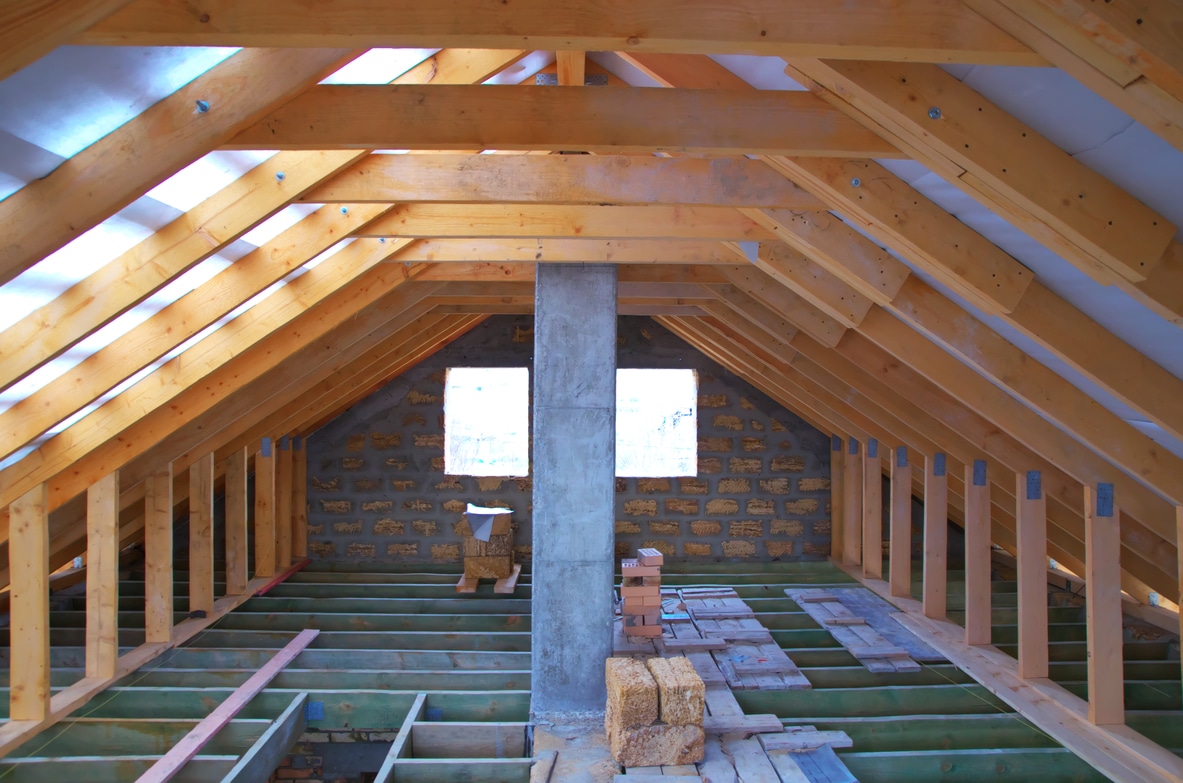Good air circulation keeps your attic healthy by using ventilation to fight against excess moisture or heat. Baffles keep air flowing through your attic by channeling it through the soffit vents. While DIYers can tackle this project independently, professional contractors know how to install attic baffles and ensure they’ll last for years.
Importance of Attic Baffles
Besides increasing and regulating airflow, baffles for your attic offers many benefits, including the following:
Moisture Prevention
Humidity in your attic can damage its structural integrity, but baffles help push that dangerous air out of your home. Excess moisture can cause the musty smell commonly associated with attics, so baffles help keep that odor from permeating the space.
Mold, Mildew, and Decay Prevention
Excess moisture in the air can spur the growth of mold, mildew, and bacteria, making your attic a health hazard. Installing baffles in your attic keeps humid, moist air from settling into the insulation and wooden support beams.
Soffit Protection
Soffits sometimes attract loose insulation, which blocks the vents and makes air circulation difficult. Attic baffles protect your soffits by preventing potential vent blockage.

Basic Functions of Baffles
Many homeowners ask, “What are baffles in the attic?” Baffles resemble chutes that fit between the attic’s interior and the soffit vents under your eaves. These chutes provide a channel through which air circulates into your attic, helping prevent moisture buildup while regulating the attic’s temperature.
Types of Attic Baffles
When installing attic baffles, you may wonder which kind works best for your home. Different types of attic baffles include:
Styrofoam Baffles
Many homeowners choose Styrofoam when installing attic baffles. Foam baffles offer a flexible, lightweight fit and cost the least of all baffle types. These baffles come with extra cones to open soffit vents and look similar to egg boxes.
Cardboard Baffles
Choosing cardboard baffles for attic insulation gives you an easy-to-use material that helps absorb moisture before it reaches your attic. Corrugated cardboard baffles allow homeowners to fold them as needed to fit each soffit vent perfectly.
Plastic Baffles
Consisting of sturdy polystyrene, plastic attic baffles can withstand the pressure and weight of insulation. Homeowners in humid areas appreciate plastic baffles because they don’t absorb moisture, allow mold growth, or make a hospitable environment for bacteria. Installing attic baffles made of plastic also enables you to adjust them to different heel heights.
Which Type of Attic Baffle Is Best?
Most homeowners believe plastic makes for the best attic baffles due to its durability and moisture resistance. However, the choice of baffle material depends on your preferences, so choose the one that best fits your attic and budget.
Attic Baffle Installation Process
Are you wondering how to install attic baffles? DIY homeowners wanting to install baffles in their attic can follow this easy attic baffle installation process:
Step One: Prepare for Installation
Before installing attic baffles, ensure that you can easily reach your rafters. You may need to remove insulation or drywall, in which case you want to make sure you use personal protective gear and the proper tools. When you’re ready to begin installing your baffles, have these tools at hand:
- Caulk
- Staple Gun
- Spray Foam
- Measuring Tape
- Utility Knife
Step Two: Measure and Cut
Measure the space between each rafter and cut the baffles to fit. Baffles should sit snugly between each rafter, with the bottom of each between the rafter and ceiling joist.
Step Three: Place and Secure
Align and secure the baffles with your staple gun. Use spray foam and caulk to seal connecting points and prevent air leaks. For the best protection, overlap your baffles and secure them to one another.
Installing attic baffles on your own may take a lot of time and money, especially if you need to purchase the equipment to install them. Your local contractor will already have the equipment and materials necessary, plus experience in attic baffle installation, so ask a professional for help if you need to install attic baffles.
How Much Do Attic Baffles Cost?
Before asking how to install baffles in their attic, many homeowners wonder how much baffle installation costs. Hiring professional installer costs between $0.75 and $1.20 per square foot, while DIYers may pay less depending on which tools and materials they need to purchase in addition to the baffles.
Frequently Asked Questions (FAQs) – Attic Baffles
Other than the classic “What are baffles in the attic?” homeowners often have many questions about installing attic baffles. Some of these questions include:
Are Baffles in the Attic Necessary?
In short, yes, you need attic baffles. Some homeowners may avoid installation over the costs, not realizing that the humidity and moisture in their attic can create more expensive problems later.
Are Baffles Expensive?
The pricing for attic baffles depends on factors such as:
- Which type do you purchase?
- Whether you have the necessary tools?
- Where do you buy your baffles from?
- Whether you opt for professional installation?
The initial cost for professional attic baffle installation typically lands below $1,000, making them an inexpensive and easy way to improve your attic’s health.
What Can I Use for Attic Baffles?
Finding an alternate object instead of purchasing regular attic baffles can waste time, money, and resources. If you need to improve your attic’s ventilation, use attic baffles available from any hardware store or through your local contractor.
Conclusion
Attic baffles help protect your attic from excess moisture, heat buildup, and foul odors by circulating outside air through the space. DIYers wondering how to install attic baffles can use the handy guide above to help them, though baffle installation requires tools, equipment, and experience they may not have. Professional contractors like Attic Projects can help.
Our attic insulation installation experts can guide you in choosing the most suitable attic baffle material, perform professional installation, and repair or replace broken attic baffles. When you’re ready to install baffles, contact Attic Projects to schedule your appointment.



